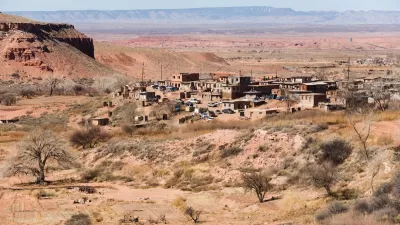After the dramatic collapse of the Minneapolis freeway bridge last week, the collective hand-wringing began. The bridge was known to be faulty, but had not been replaced. Our entire public transit system is underfunded, we were told.In addition to transportation infrastructure, those concerned with urban issues have a litany of complaints about American cities. Our transit systems are not adequately linked to zoning laws. Our high parking requirements doom alternative modes of transit and drive up development costs. Our policies encourage uncontrolled sprawl, which seemingly nobody likes. Planners' recommendations are too often overruled by ill-informed and politicized zoning boards. Our buildings aren't energy efficient. City mayors and councils play politics with projects painstakingly approved through highly democratic review processes. And nobody's happy when local activists hold undue power over individual projects. The solutions we are given are almost as varied as the problems. More centralized planning is often called for, or perhaps more regional planning. However, this seems highly difficult and unlikely in most places where land use is regulated by many small municipalities. Some suggest the solution is more public input on infrastructure and private projects to enhance their quality, while others think we need less input to speed them along and reduce the costs incurred by delays. Some are convinced elaborate flexible or form-based zoning holds the key to better cities, although implementation seems frustratingly difficult. Some cynics conclude that perhaps it is American cultural biases that produce our flawed cities: maybe Americans just like it this way, living with decaying infrastructure, long commutes, but low taxes. The motley list of solutions almost never includes the one thing that actually has overcome the myriad of obstacles to good city building before: a broad-based and robust conversation to create solutions, money, and political support.
After the dramatic collapse of the Minneapolis freeway bridge last week, the collective hand-wringing began. The bridge was known to be faulty, but had not been replaced. Our entire public transit system is underfunded, we were told.
In addition to transportation infrastructure, those concerned with urban issues have a litany of complaints about American cities. Our transit systems are not adequately linked to zoning laws. Our high parking requirements doom alternative modes of transit and drive up development costs. Our policies encourage uncontrolled sprawl, which seemingly nobody likes. Planners' recommendations are too often overruled by ill-informed and politicized zoning boards. Our buildings aren't energy efficient. City mayors and councils play politics with projects painstakingly approved through highly democratic review processes. And nobody's happy when local activists hold undue power over individual projects.
The solutions we are given are almost as varied as the problems. More centralized planning is often called for, or perhaps more regional planning. However, this seems highly difficult and unlikely in most places where land use is regulated by many small municipalities. Some suggest the solution is more public input on infrastructure and private projects to enhance their quality, while others think we need less input to speed them along and reduce the costs incurred by delays. Some are convinced elaborate flexible or form-based zoning holds the key to better cities, although implementation seems frustratingly difficult. Some cynics conclude that perhaps it is American cultural biases that produce our flawed cities: maybe Americans just like it this way, living with decaying infrastructure, long commutes, but low taxes.
The motley list of solutions almost never includes the one thing that actually has overcome the myriad of obstacles to good city building before: a broad-based and robust conversation to create solutions, money, and political support.
This argument isn't new, and is well articulated by historian Robert Fishman. In his contribution to the volume the American Planning Tradition, he argues the tradition has not been a story of centralized, rational planning, coordinated through governmental agencies. In his view, the great planning accomplishments of American history were instead the product of a great "urban conversation" where elites and common citizens alike engaged in an "intense and impassioned" discussion of urban and regional strategies. Fueled by the selfish interests of both the actors and the cities themselves, this urban conversation is the true source of the power in directing the development of our cities. Indeed, history shows Americans have invested heavily in common infrastructure in the past, building freeways and transit, urban parks, train stations, ballparks, and convention centers.
We are living through remarkable times, when the very medium of our urban conversation is being transformed. No longer are our major urban newspapers the exclusive forum for the civic minded. Newspaper circulation and readership has declined, niche publications catering to various interests and languages have sprung up. The most potent tool of this revolution - the internet - has exploded in influence and scope over the past decade. At a fundamental level, it has empowered every organization and every individual to communicate directly with any other person on the planet.
As we might expect, this has changed the nature of the urban conversation fundamentally. No longer does it take place through several well-known forums, today it happens on websites, over neighborhood email lists, in blog comments, on message boards, or through email threads among co-workers or friends. While there is much disorienting about this brave new world, it has empowered citizens to seek direct information from the government. Now, every citizen can look up the value of their house, read about government programs, or order government services online. Most importantly, internet technology represents a potent toolkit for those savvy enough to leverage it. Online campaigns have raised money and generated interest in hundreds of obscure causes. The company Meetup.com has 20,000 interest groups "meeting up" in hundreds of U.S. cities. Local political candidates use blogs, websites, and email to connect with voters and raise money, even at the neighborhood level. Indeed, it seems these technologies have the greatest potential for impact at the local level – with their low start-up cost, rapid scalability, and increasing ease of use.
Our city planners - whether bureaucrats, elected officials, citizen advocates, or builders - must embrace the new technology if they hope to realize their plans for our cities. For their part, even the best government planners work on the web is often limited to static online pamphlets about completed plans, or legalistic documents supporting development review processes. At their worst, there is a simple lack of any online information whatsoever about the planning process. Government planners, with their unique access to information and role in the official approval processes, play an instrumental role in facilitating the conversation. Internet technology is the best way to reach many people quickly, cheaply, and at their own convenience.
I have suggested in the past some of the ways planners might use these tools. A project I am involved with in College Park is an experiment on what one model might look like. At the very least, every agency should seek to maximize the amount and availability of their vast stores of information. While I won't suggest planners become advocates for specific political positions, as some might suggest is needed, I will insist planners must be unflinching advocates for conversation and engagement itself. We need government websites with clear and accurate data, personal sites crusading against corrupt zoning commissioners, nitpicking new projects, and posting videos of public hearings on YouTube. We need regional campaigns demanding better cooperation and more money spent on transit and open space preservation. Urban advocates of all stripes must move aggressively into the public and political realm using the best tools available, if we hope to be successful.
Of course, there are good reasons the field has not seized upon these tools. Many are still learning about their uses and potential. Governments are notoriously conservative organizations and limited by a host of laws complicating adventurous online experimentation. Planners are often overworked, struggling to complete development applications on time, let alone facilitate a complex conversation. Fishman himself argues that the successful planning processes in the past were often not initiatied or even led by government planners.
It seems clear to me those committed to improving American cities must plan for the power it takes to mobilize the ideas, money, and votes necessary for urban investment and change. It just might be the only approach that will work.

Trump Administration Could Effectively End Housing Voucher Program
Federal officials are eyeing major cuts to the Section 8 program that helps millions of low-income households pay rent.

Planetizen Federal Action Tracker
A weekly monitor of how Trump’s orders and actions are impacting planners and planning in America.

The 120 Year Old Tiny Home Villages That Sheltered San Francisco’s Earthquake Refugees
More than a century ago, San Francisco mobilized to house thousands of residents displaced by the 1906 earthquake. Could their strategy offer a model for the present?

HSR Reaches Key Settlement in Northern California City
The state’s high-speed rail authority reached an agreement with Millbrae, a key city on the train’s proposed route to San Francisco.

Washington State Legislature Passes Parking Reform Bill
A bill that would limit parking requirements for new developments is headed to the governor’s desk.

Missouri Law Would Ban Protections for Housing Voucher Users
A state law seeks to overturn source-of-income discrimination bans passed by several Missouri cities.
Urban Design for Planners 1: Software Tools
This six-course series explores essential urban design concepts using open source software and equips planners with the tools they need to participate fully in the urban design process.
Planning for Universal Design
Learn the tools for implementing Universal Design in planning regulations.
Ada County Highway District
Clanton & Associates, Inc.
Jessamine County Fiscal Court
Institute for Housing and Urban Development Studies (IHS)
City of Grandview
Harvard GSD Executive Education
Toledo-Lucas County Plan Commissions
Salt Lake City
NYU Wagner Graduate School of Public Service






























